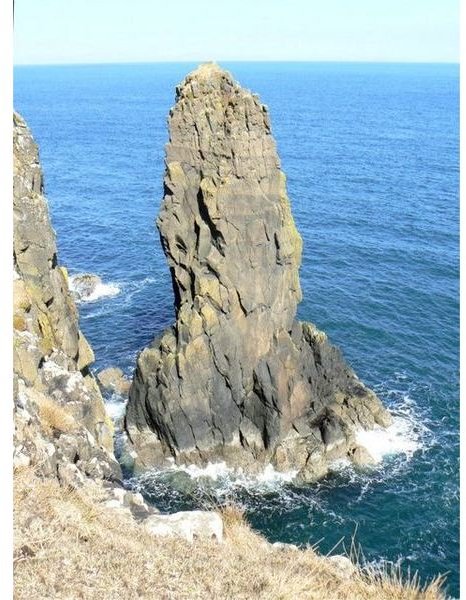How Are Sea Stacks Formed?
What Are Sea Stacks?
While on the beach, you may notice huge rocks that jut toward the sky. They stand out from the beach formations such as the headlands or they may shoot out of the water, looking completely out of place. The single column or columns of rock is called a “sea stack”.
The sea stack is a rock structure that is formed by a natural process – erosion. A stack is made up of a steep or upright column or columns if there are more than one and lie in the sea near a coast.
Examining how these strange columns form in a sea begs the questions, “How do these columns get here?” or “How are sea stacks formed?”
Sea stacks are formed through a very long, natural process of erosion. Due to the erosion process, they can also be unstable. All of the rock at the bottom of these columns is weak from the erosion processes and cracks or wedges that may have formed during the process.
Sea Stack Formation Process

So how are sea stacks formed? Headlands that jut outward into an open body of water such as an ocean leave the land formations unprotected against years of wind and wave erosion. As the water smashes up against the headland rock, the erosion process begins. Waves chisel away at the rock and over time a cave is formed. Another factor of the erosion process that forms sea stacks is wind. Both wind and water pound heavily on the rock pieces to crack and weaken the stone.
Waves continue to smash into the cave throughout the years, breaking pieces of rock away slowly. Cracks and weak places are created due to the amount of force with which the waves smash into the cave, especially during storms and swells.
Eventually, the cave will give way and the water will drill its way on through the back of the cave, thus creating an arch ove
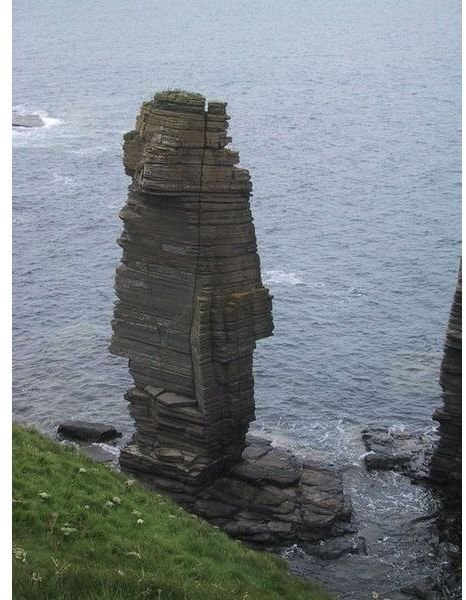
r the open section. The arch may survive the destructive forces of the waves and break away to reveal one large stack of rock. This is the sea stack.
Once the sea stack is formed, the waves continue to smash into it as well. Eventually, over time, this stack will break away, throwing pieces of rock into the sea and on land. The piece that remains is known as a stump.
For example, the sea stacks in Lagos, Portugal, the coastline were relatively sheltered; however, the force from the North Atlantic swells struck at the rock until they gave way to caves and then sea stacks.
The sea stacks in Portugal are composed of a brittle, unstable sedimentary rock layering, so a calmer wave action had the ability to create the sea stacks and arches of the area.
Illustrations of How Sea Stacks Form
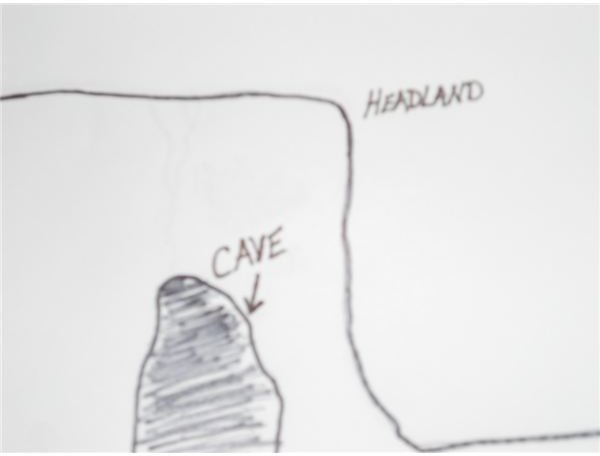
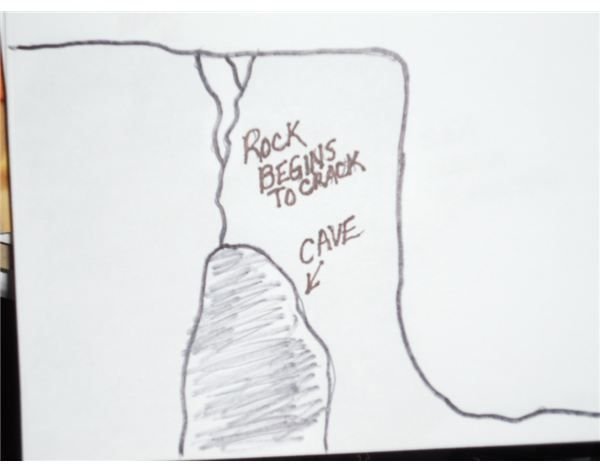
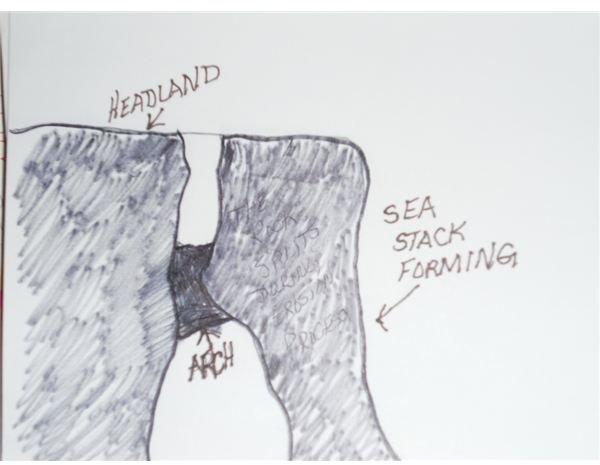

What Are Some of the Most Famous Sea Stacks?
Some sea stacks have become world renowned due to their individual formations and size. Ten of the most famous are listed here,
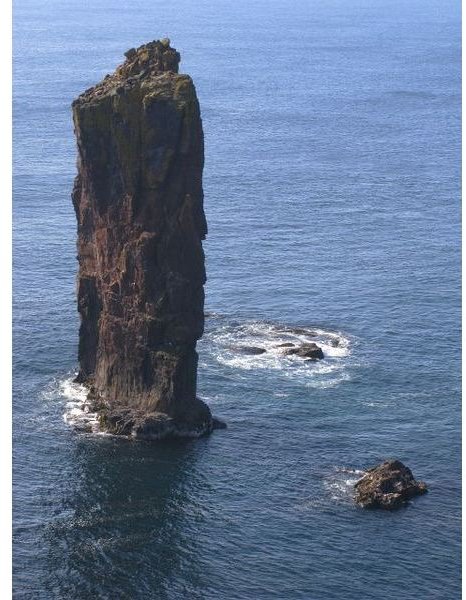
but there are many more.
New Brunswick is the home to dark sedimentary and sandstone rock formations known as the Hopewell Rocks. The tides of the Bay of Fundy (some of the highest tides in the world that can reach up to 98 feet) created these monstrosities. The tides roll in twice a day, eroding the rock in the land. At low tide, tourists and residents can examine the sandstone pillars. The various rock formations include names such as “ET”, “Mother-in-Law” and “Lover’s Arch.”
Located along the coast of Oregon, Haystock Rock is the third tallest volcanic stack in the world. The sea stack was formed by lava that flowed from the Grand Ronde Mountains millions of years ago. Years of erosion have separated Haystock Rock from the headland that sits nearby. Home to many birds, including puffins and terns, the monolith has been seen in movies such as “The Goonies”, “Kindergarten Cop” and “1941”.
Port Campbell National Park in Victoria, Australia houses a few stacks in a collection known as the Twelve Apostles. The stacks here were formed by constant wind and tide erosion processes against the limestone cliffs that occurred over millions of years. The stacks created caves, which eventually became arches. These arches collapsed to form what was initially called the “Sow and Piglets.” The name for these stacks changed to The Twelve Apostles in the 1950s to lure more tourists, even though there were only nine stacks left.
Red sandstone stacks stand 449 feet high on the Island of Hoy, Scotland. The “Old Man of Hoy” is believed to be about 400 years old, and is famous for being a rock-climbing site. The first rock climber to attempt this feat was in 1966. The stack also made the music scene with its appearance in the opening scene of the Eurythmics’ video “Here Comes the Rain Again” in 1984.
Dorset England boasts chalk stacks called “Old Harry Rocks.” These stacks are considered a part of the Jurassic Coast World Heritage site. Because of erosion, Old Harry may not exist for much longer. Stacks have already begun to collapse, including Old Harry’s original wife, which fell in 1896. Various groups have been working on the preservations of these formations.
Am Buachaille is a very tall, vertical formation in the Scottish county, Southerland. The stack was climbed in 1968. Am Buachaille translates to “The Shepherd” in Scottish Gaelic.
In the Lord Howe Island Marine Park in the Pacific Ocean, Ball’s Pyramid juts upward to the height of 1,843 feet. This volcanic stack is a plug of a shield volcano and caldera, which formed millions of years ago. The Ball’s Pyramid sea stack is the tallest volcanic stack in the world. The stack was successfully climbed on Valentine’s Day in 1965.
Three stacks, known as the Tri Brata, stand at the entrance of Avacha Bay. These stacks are thought of as a symbol of the main city of Kamchatka Krai, Russia, which is called Petropavlovsk-Kamchatsky. Legend tells tales of three brothers who went to defend a town from a tsunami but during the battle, turned to pillars of stone.
Isle of Wight, England is home to three chalk stacks known as “The Needles”. The columns were shown in the 2005 program, “Seven Natural Wonders” as one of the wonders of southern England. One pillar (known as Lot’s Wife) collapsed in 1764. The 120 foot needle-shaped pillar gave way to erosion and is the reason the pillars received their name. A 109-foot high lighthouse stands at the western end of the formation and has been there since 1859.
“Long Anna” or “Tall Anna” is translated from the Lange Anna of title the 154-foot sea stack in the sandstone of the island of Heligoland, Germany. The rock column is estimated to weigh in at approximately 25,000 tons. The base of this beauty is protected by a man-constructed sea wall.
Sources
Kristie, K; Scienceray; “10 Famous Sea Stack Formations”, May 25, 2009; https://scienceray.com/earth-sciences/geology/10-famous-sea-stack-formations/2/
Relichounds and Kiwibirdman; Geocaching; “San Joseph Bay Sea Stacks”, May 23, 2010; https://www.geocaching.com/seek/cache_details.aspx?guid=84bbfdae-a657-447f-b206-08e9381054e6
Author Unknown; Coastal National Parks; Coastal Geology; https://www.nature.nps.gov/views/KCs/CoastalG/HTML/ET_Environments.htm
Images
Sea stack - geograph.org.uk by James Allen under Attribution: James Allen CCA by 2.0 SA
Sea stack and arch - geograph.org.uk by Doug Lee under Attribution: Doug Lee CCA by 2.0 SA
Sea Stack at Girnigoe - geograph.org.uk by Sarah Charlesworth under Attribution: Sarah Charlesworth CCA by 2.0 SA
Snolda sea stack - geograph.org.uk by Doug Lee under Attribution: Doug Lee CCA by 2.0 SA
Simplistic Illustrations of how sea stacks are formed; Perry, Vicki; June 16, 2011
